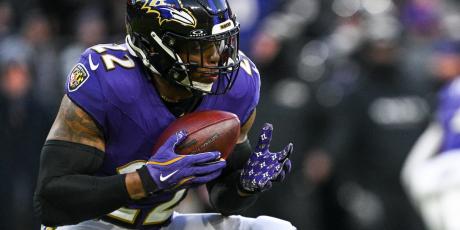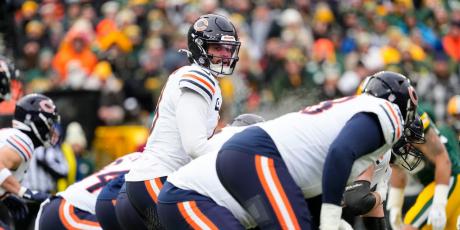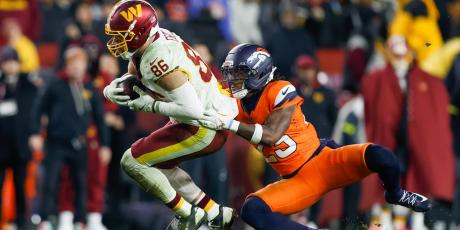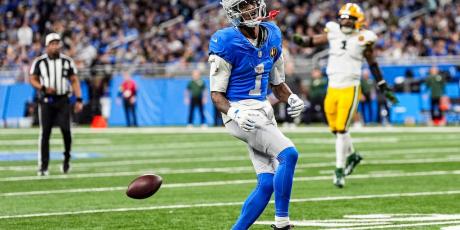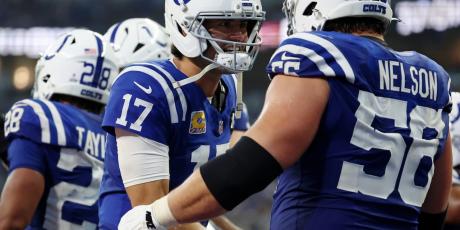How Offensive Line Play Impacts Fantasy Football
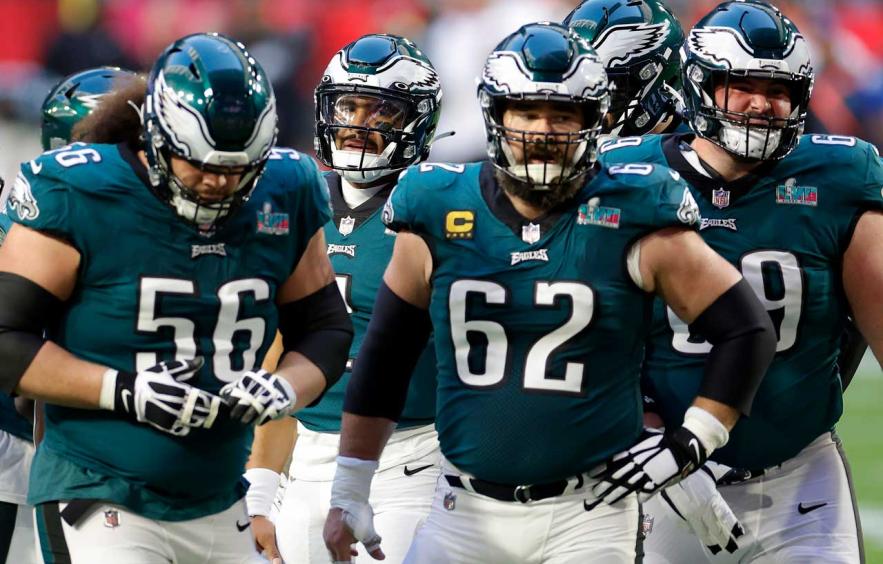
Fantasy football is hard. Each year begins anew with a draft class chock full of names you’ve likely only heard of in the two months prior, free-agent signings with unknown statistical impact, coaching hires, and coordinator promotions that can and will affect play calling. It’s a lot to wrap your head around. But this doesn’t stop us from logging on and scouring the internet for edges on our opponents through Twitter, draft guides, and, of course, 4for4, the most useful tool you can be using. Yet, amongst the thousands of articles and tweets at your disposal, there is still a key component left out by the most astute writer’s analytical process: the offensive line.
Outlier plays (and players) can make “broken” plays, or scramble drills make it seem like talent can rise above a lack of blocking. Maybe it can, but not for a sustained amount of time. What we’re looking for from our fantasy players is predictability and, in our season-long leagues, consistency. What is consistent is the fact that all quarterbacks in the league have a lower quarterback rating when pressured than when kept clean. A quarterback’s yards and completion percentages are the third and fourth-most sticky statistics year-over-year, both exceedingly difficult things to do with a hand in your face or your back on the ground.
In the running game, it should come as no surprise when teams that emphasize investing in their offensive line and creating unique schemes produce consistent fantasy-relevant running backs. Some of the best run-blocking units in the last half-decade have generated backfields we are prone to target.
For the remainder of this article, I’ll be explaining the methods to the madness of quantifying offensive line play and exactly how we can translate that into actionable information pertaining to counting stats and fantasy football.
Relevant Offensive Line Statistics
Below are some of the basic stats I used to create my offensive line metric, which ranks each team’s offensive line. Weighted in terms of importance, the final score attempts to measure exactly how much an O-Line will help or hurt a team's fantasy output.
- QB Pressure Rate Allowed – The percentage of passing plays in which the quarterback was hurried, hit, or knocked down.
- Adjusted Sack Rate – From Football Outsiders, “Adjusted Sack Rate, which gives sacks (plus intentional grounding penalties) per pass attempt adjusted for down, distance, and opponent.” My favorite part of this stat is the down and distance bit of the metric, as it weighs a drive-killing sack on 3rd-and-1 more heavily than a 3rd-and-25 sack during a fledgling drive.
- Yards Before Contact - Just as it sounds, the average amount of yards that a team’s running back group earns before a defender makes contact with them.
- Adjusted Line Yards – Coming from FO again, this formula assigns responsibility to the offensive line to varying degrees depending on the length of a run (0–4 yards, 5–10 yards, 11+ yards, and loss of yardage). Those numbers are adjusted by “down, distance, situation, opponent and the difference in rushing average between shotgun compared to standard formations”.
- Number of Starters – This is simply the number of offensive linemen that were forced into a starting role throughout the season. This makes for a quick reference point for teams that are dealing with injuries or are forced to start a perceived less-talented player for one reason or another.
- Number of Offensive Line Penalties – This incorporates all penalties assessed to offensive linemen on a team, though holding calls and false starts generate a vast majority of the numbers. I’ve decided to include all penalties, whether accepted or declined, as it is not possible to parse out exactly whether a call should have been made (or accepted) without watching each penalty individually. And believe me, we both have better things to be doing with our time. Though this is not an all-encompassing stat for judging a team’s discipline, it’s important to see which teams have been more likely to kill drives with mistakes.
- Blown Blocks - Sports Info Solutions’ metric for how often a player does not successfully block the defender they attempted to engage. This is represented in the overall metric in terms of percentage; the higher percentage the team misses a defender, the bigger the detriment to their overall grade.
- Coach Tenure - A numerical representation of how long teams have been able to coach the same types of blocking schemes season-to-season. This is simply how long the offensive line coach has been with the team. Another attempt to quantify continuity.
How this Data Correlates to Fantasy Points
To put these statistics into relevant context, I have graphed each offensive line statistic versus every team’s 2022 total half-PPR points to find the r-squared on a fitted regression line. A table of the full findings follows, but I wanted to include one of the graphs to help explain what this process looks like (and to show my work a little bit).
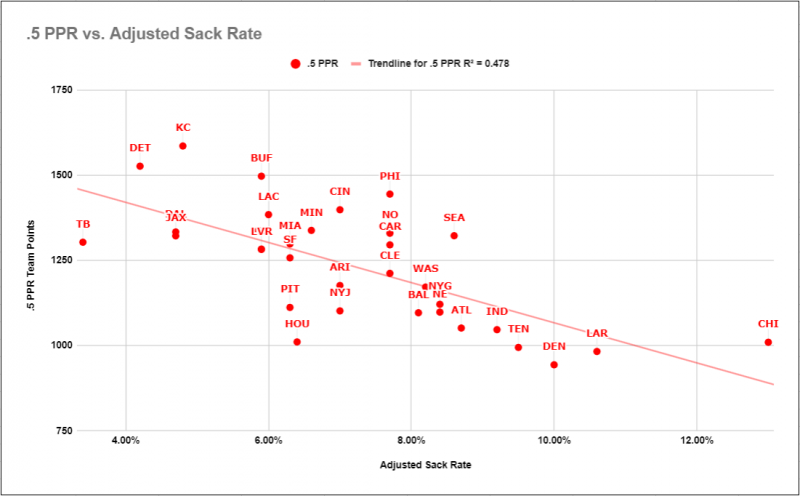
Adjusted Sack Rate does a great job on its own in regards to predicting fantasy scoring for an NFL team. It makes sense, as a sack is incredibly detrimental to a team’s success on a given drive, particularly if that sack occurs on third down or deep in an opponent’s territory. It’s an easy way to convert future offensive fantasy points into only three points for the team’s kicker.
Teams in the upper-left-hand corner were effective at keeping their quarterbacks clean in crucial situations, and this is one reason why teams like the Lions, Chiefs, Jaguars, and Bills were such fantasy-scoring machines. On the flip side, adjusted sack rate also helps in explaining why fantasy pieces for the Bears, Rams, and Broncos were left to rot on our benches.
This would be as good of a time as any to clarify that I’m not trying to say that the quality of an O-Line is going to be the end-all, be-all of why teams can/cannot score fantasy points; I just want to illustrate that they are a bigger piece of the puzzle than they are given credit for.
The adjusted sack rate metric offered the highest correlation (48%) to fantasy points of any of the individual statistics I delved into, but let’s take a look at the rest.
| O-Line Metric | Correlation |
|---|---|
| Adjusted Sack Rate | 0.48 |
| # of Starters | 0.24 |
| QB Pressure Rate | 0.20 |
| Yards Before Contact | 0.11 |
| Adjusted Line Yards | 0.09 |
| Blown Block% | 0.05 |
The second-highest correlation between 2022’s fantasy success and its offensive line was the number of starters a team was forced to play throughout the year. This can be explained by both the lack of continuity (see Thomas Emerick’s work on that subject for more on the matter) being a detriment to the unit’s overall performance and the downgrade in talent that nearly always takes place when a backup is forced into a full-time role.
We have some acceptable correlations from this exercise. I would be satisfied knowing that an offensive line’s allowed pressure rate could explain a fifth of that team’s fantasy points or even that their yards before contact could explain a ninth of a team’s cumulative fantasy points. I think we can make these numbers even more descriptive without actually changing the numbers, but how?
As I’ve often preached, this data and the offensive line work I do generally are better used to discover the outlier teams to avoid or attack. Meaning let’s target teams in the top 10 and avoid teams in the bottom 10 for offensive purposes and the opposite for defensive purposes. Can we make these correlations look better if we exclude the teams ranked 11th through 22nd in a given metric and instead focus on the best and worst teams?
| O-Line Metric | Correlation |
|---|---|
| Adjusted Sack Rate | 0.69 |
| QB Pressure Rate | 0.32 |
| # of Starters | 0.30 |
| Adjusted Line Yards | 0.16 |
| Yards Before Contact | 0.15 |
| Blown Block% | 0.13 |
Each of our featured statistics becomes more descriptive when we eliminate the middle of the spectrum to shine the light on the highs and lows of offensive line play. Adjusted sack rate, for example, becomes incredibly strong when we only focus on the best and worst teams in that given metric. But there are still some frayed ends to clean up here. What if we incorporate all of these into a single metric, weighted by statistical importance, and use that to compare against a team’s fantasy production?
What's this all-encompassing metric, and does it correlate well?
| O-Line Metric | Correlation |
|---|---|
| All-Encompassing Offensive Line (AEOL) | 0.55 |
| Adjusted Sack Rate | 0.48 |
| # of Starters | 0.24 |
| QB Pressure Rate | 0.20 |
| Yards Before Contact | 0.11 |
| Adjusted Line Yards | 0.09 |
| Blown Block% | 0.05 |
When we weight all of the metrics I use into a single model, it does become stronger than any one number and ends up being the first piece of the puzzle that I use while ranking offensive line units in-season on a week-to-week basis.
Now let’s take a look at our weighted metric when we compare only to the top-10 and bottom-10 units.
| O-Line Metric | Correlation |
|---|---|
| All-Encompassing Offensive Line (AEOL) | 0.73 |
| Adjusted Sack Rate | 0.69 |
| QB Pressure Rate | 0.32 |
| # of Starters | 0.3 |
| Adjusted Line Yards | 0.16 |
| Yards Before Contact | 0.15 |
| Blown Block% | 0.13 |
As we already saw, all of these metrics become stronger when focusing on the top-10 and bottom-10 in that given category, and the AEOL follows the same path. The AEOL metric helped to explain almost three-fourths of the fantasy points scored by the top and bottom offensive line units in the league. Someone still has to touch the ball to get sacked, or get hit behind the line, or miss the gap that has been blocked for them, but I’ve chosen these statistics due to how well I believe they do a very difficult task —separate offensive line play from a team’s skill position players.
By adding context (film watching, injuries, competition, etc.) to this significantly strong baseline, we now have a formula that can lead us towards fantasy options on good blocking teams and away from fantasy options on poor blocking teams.
There are outliers, and there will always be outliers, but it doesn’t mean we can’t use offensive line play as another data point when deciding on who to roster and play.
Further Reading
A (very reasonable) question I’ve received a lot in the past is how (or if) we can separate my offensive line research into buckets of rushing and passing. While a very valid inquiry (and one I’m not apt to give up on any time soon), the short answer is “no.” For the time being, I believe this metric and the rankings that will come from it are best looked at in an environmental sense. Good offensive lines equal a good environment for increased yardage and are less likely to allow drives that stall into punts and field goals.
Once we get into massive, lengthy rankings articles, there will be a lot to parse out, and some offensive linemen are objectively better in pass protection than they are in run-blocking. That information often comes wholly from the eye test, so you’ll just have to keep your eye on the 4for4 front page as offensive line content continues through the summer.
Bottom Line
- By strengthening the offensive line, NFL teams create ripe situations for fantasy production.
- No single statistic can explain all of a team’s output, but if we weigh the important ones, we get a better idea of how much they influence a skill position player's stock.
- Providing context and creating rankings of all 32 units will give us an advantage over fantasy owners who ignore this vital piece of the pie.


